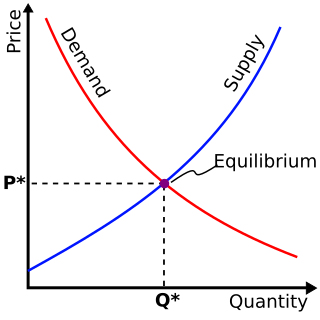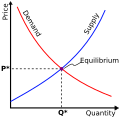
Economics is a social science that studies the production, distribution, and consumption of goods and services.

Macroeconomics is a branch of economics that deals with the performance, structure, behavior, and decision-making of an economy as a whole. This includes regional, national, and global economies. Macroeconomists study topics such as output/GDP and national income, unemployment, price indices and inflation, consumption, saving, investment, energy, international trade, and international finance.

Kenneth Joseph Arrow was an American economist, mathematician and political theorist. He received the John Bates Clark Medal in 1957, and the Nobel Memorial Prize in Economic Sciences in 1972, along with John Hicks.
A natural experiment is a study in which individuals are exposed to the experimental and control conditions that are determined by nature or by other factors outside the control of the investigators. The process governing the exposures arguably resembles random assignment. Thus, natural experiments are observational studies and are not controlled in the traditional sense of a randomized experiment. Natural experiments are most useful when there has been a clearly defined exposure involving a well defined subpopulation such that changes in outcomes may be plausibly attributed to the exposure. In this sense, the difference between a natural experiment and a non-experimental observational study is that the former includes a comparison of conditions that pave the way for causal inference, but the latter does not.
In the social sciences, methodological individualism is a method for explaining social phenomena strictly in terms of the decisions of individuals, each being moved by their own personal motivations. In contrast, explanations of social phenomena which assume that cause and effect acts upon whole classes or groups are deemed illusory, and thus rejected according to this approach. Or to put it another way, only group dynamics which can be explained in terms of individual subjective motivations are considered valid. With its bottom-up micro-level approach, methodological individualism is often contrasted with methodological holism, a top-down macro-level approach, and methodological pluralism.

Ernst Louis Étienne Laspeyres was a German economist. He was Professor ordinarius of economics and statistics or State Sciences and cameralistics in Basel, Riga, Dorpat, Karlsruhe, and finally for 26 years in Gießen. Laspeyres was the scion of a Huguenot family of originally Gascon descent which had settled in Berlin in the 17th century, and he emphasised the Occitan pronunciation of his name as a link to his Gascon origins.
In macroeconomic theory, liquidity preference is the demand for money, considered as liquidity. The concept was first developed by John Maynard Keynes in his book The General Theory of Employment, Interest and Money (1936) to explain determination of the interest rate by the supply and demand for money. The demand for money as an asset was theorized to depend on the interest foregone by not holding bonds. Interest rates, he argues, cannot be a reward for saving as such because, if a person hoards his savings in cash, keeping it under his mattress say, he will receive no interest, although he has nevertheless refrained from consuming all his current income. Instead of a reward for saving, interest, in the Keynesian analysis, is a reward for parting with liquidity. According to Keynes, money is the most liquid asset. Liquidity is an attribute to an asset. The more quickly an asset is converted into money the more liquid it is said to be.
Richard Ferdinand Kahn, Baron Kahn, CBE, FBA was a British economist.

Family economics applies economic concepts such as production, division of labor, distribution, and decision making to the family. It is used to explain outcomes unique to family—such as marriage, the decision to have children, fertility, time devoted to domestic production, and dowry payments using economic analysis.
In mathematics, a vector measure is a function defined on a family of sets and taking vector values satisfying certain properties. It is a generalization of the concept of finite measure, which takes nonnegative real values only.
Lawrence E. Blume is the Distinguished Arts and Sciences Professor of Economics and Professor of Information Science at Cornell University, US.
Involuntary unemployment occurs when a person is unemployed despite being willing to work at the prevailing wage. It is distinguished from voluntary unemployment, where a person chooses not to work because their reservation wage is higher than the prevailing wage. In an economy with involuntary unemployment, there is a surplus of labor at the current real wage. This occurs when there is some force that prevents the real wage rate from decreasing to the real wage rate that would equilibrate supply and demand. Structural unemployment is also involuntary.
Peter Kenneth Newman was an English economist and historian of economic thought. He helped to edit The New Palgrave: A Dictionary of Economics, to which he contributed several articles.

In economics, scarcity "refers to the basic fact of life that there exists only a finite amount of human and nonhuman resources which the best technical knowledge is capable of using to produce only limited maximum amounts of each economic good." If the conditions of scarcity did not exist and an "infinite amount of every good could be produced or human wants fully satisfied ... there would be no economic goods, i.e. goods that are relatively scarce..." Scarcity is the limited availability of a commodity, which may be in demand in the market or by the commons. Scarcity also includes an individual's lack of resources to buy commodities. The opposite of scarcity is abundance. Scarcity plays a key role in economic theory, and it is essential for a "proper definition of economics itself".
"The best example is perhaps Walras' definition of social wealth, i.e., economic goods. 'By social wealth', says Walras, 'I mean all things, material or immaterial, that are scarce, that is to say, on the one hand, useful to us and, on the other hand, only available to us in limited quantity'."

Macroeconomic theory has its origins in the study of business cycles and monetary theory. In general, early theorists believed monetary factors could not affect real factors such as real output. John Maynard Keynes attacked some of these "classical" theories and produced a general theory that described the whole economy in terms of aggregates rather than individual, microeconomic parts. Attempting to explain unemployment and recessions, he noticed the tendency for people and businesses to hoard cash and avoid investment during a recession. He argued that this invalidated the assumptions of classical economists who thought that markets always clear, leaving no surplus of goods and no willing labor left idle.
Ross Marc Starr is an American economist who specializes in microeconomic theory, monetary economics and mathematical economics. He is a professor at the University of California, San Diego.
In economics, non-convexity refers to violations of the convexity assumptions of elementary economics. Basic economics textbooks concentrate on consumers with convex preferences and convex budget sets and on producers with convex production sets; for convex models, the predicted economic behavior is well understood. When convexity assumptions are violated, then many of the good properties of competitive markets need not hold: Thus, non-convexity is associated with market failures, where supply and demand differ or where market equilibria can be inefficient. Non-convex economies are studied with nonsmooth analysis, which is a generalization of convex analysis.

Convexity is a geometric property with a variety of applications in economics. Informally, an economic phenomenon is convex when "intermediates are better than extremes". For example, an economic agent with convex preferences prefers combinations of goods over having a lot of any one sort of good; this represents a kind of diminishing marginal utility of having more of the same good.
Garett Jones is an American economist and author. His research pertains to the fields of macroeconomics, monetary policy, IQ in relation to productivity, short-term business cycles, and economic development. He is an associate professor at George Mason University and the BB&T Professor for the Study of Capitalism at the Mercatus Center.
B. Douglas Bernheim is an American professor of Economics, currently the Edward Ames Edmunds Professor of Economics at Stanford University; his previous academic appointments have included an endowed chair in Economics and Business Policy at Princeton University and an endowed chair in Insurance and Risk Management at Northwestern University’s J.L. Kellogg Graduate School of Management, Department of Finance. He has published many articles in academic journals, and has received a number of awards recognizing his contributions to the field of economics. He is a partner with Bates White, LLC an economic consulting firm with offices in Washington, D.C., and San Diego, California.






